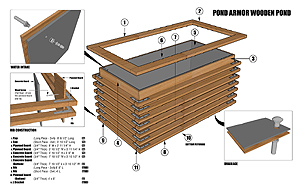I have seen people build wooden pond and holding tanks that looked great, only to see them leak like a sieve. For those of you that do not know what a sieve is, it is a meshed kitchen instrument used for straining liquids. You get the picture.
Usually the construction method starts out sound and with very good intent, but quickly goes awry from there. Generally speaking, most wood pond failures start with the outside of the wooden pond or tank rather than the inside. People tend to forget how much one gallon of water weighs. Do you know?
8.34 pounds! That is how much one gallon of fresh water weighs. Salt water tends to weigh more. That is not to say that the small amount of salt you have in your fresh water pond will add up to much though, because you are using so little of it to begin with.
All of this water will add up in weight that is applied to the walls of the pond or tank. For instance, a simple holding tank that measures 8 feet long by 4 feet wide by 4 feet tall will have about 7,989 pounds of water in it. Consider this, at 4 inches of depth, the weight is 479 pounds.
Now 479 pounds may not sound too bad, but think of the stress that small amount of water puts on the tanks along the floor/wall seams. If the floor bows, those seams can split and will definitely leak. Imagine it at capacity, 7,989 pounds! This is why I said most of the troubles usually start on the outside of the wood pond or tank.
Consider any reinforcing structure for a minute. To keep that floor from bowing, you’d have to reinforce it much like the upstairs floor of a home or apartment is reinforced. I say much like only because in a floor of a building, it is possible to allow for flexibility, where with a pond or tank, the flexibility has to be reduced to almost nonexistent.
The same can be said for the walls. As more water is put into the pond or tank, the walls will want to bow outwards without proper reinforcement. This will cause leaks in both the floor/wall seams as well as the wall/wall seams. Now let’s take a look at how to overcome this.
When I said that the reinforcement should be much like the reinforcement found in an upstairs floor or apartment, I wanted you to picture those beams that run under the floor. For almost any living quarters, those beams are usually set at either 12 or 16 inch intervals.
With a wood pond or holding tank, those beams should be much closer, usually 3 to 4 inches apart will do the trick. Remember, the reason why you need them closer is so that the wood does not bow under the weight of the water. Take a look at the image in this article and you’ll see what I mean. If you click the image, you can download a larger version for closer inspection.
In this scenario, 3/4 inch plywood is used for the walls. You can use 1 inch if you’d like, but be sure to choose an outdoor grade of plywood. Outdoor grades of plywood have a more water resistant glue that binds the veneer layers which will come in handy should water get on them. Construct your basic box from the sheets of plywood using screws, not nails.
Once the box is built, you will need to cut 2x4s to run the length and width as well as under the bottom of the box. It’s not a good idea to plan to just sit the box on flat concrete floor because you will end up with no way of cleaning up and spilled water or anything like that. So plan to rib the bottom of the floor and set the unit on the ribs at least.
Now the 2x4s will be placed onto the walls standing on edge rather than lying flat. This is where the rib strength will come from. Start at either the bottom or the top and be sure to end flush at the opposing edge by either adjust the last rib or adding a rib to accommodate. It is important to make sure the edges have very good structural integrity. Make sure that the ribs overlap one another at the ends of the box and screw them together there.
If you plan to have drains or any incoming pipe coming into the pond or tank, those holes should be cut out prior to placing ribs near those locations and the placement should take into account keeping the ribs in their prescribed locations. Use a hole saw to cut these out and plan to use bulkhead fittings where the pipe will come through the box. Bulkhead fittings will make the transition not only look better but be virtually leak free in the end.
You will notice from the diagram that concrete board is being used on the inside of the tank. This concrete board is also known as hardy board. The reason it is being used is because if the plywood ever delaminates for any reason, the coating applied to the inside will fail too. This is not to mention the overall strength that the concrete board will also provide. Hardy board are not a necessity, but a nicety. I have seen many people build without it successfully, so you decide which direction you will take with yours.
So you glue the concrete board in place and then seal it with Pond Shield epoxy. Use fiberglass strips on the seams to provide extra strength. Once all is done, the pond or tank can be filled up. This design certainly can be modified to accommodate additional tanks being added in line too. Happy building!



